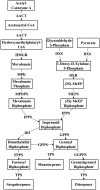The Science behind vegetable aromas: types, synthesis, and influencing factors of volatile compounds
- PMID: 40650942
- PMCID: PMC12258172
- DOI: 10.1080/15592324.2025.2527958
The Science behind vegetable aromas: types, synthesis, and influencing factors of volatile compounds
Abstract
Volatile organic compounds (VOCs) are key determinants of the aroma characteristics in vegetable crops. They not only directly affect consumer sensory experiences but also play important roles in plant - environment interactions. With the continuous advancement of analytical technologies, the composition, biosynthetic pathways, and regulatory mechanisms of VOCs in vegetables have become research hotspots in recent years. This review systematically summarizes the major types of VOCs (aldehydes, esters, terpenes, and sulfur-containing compounds) in vegetable crops and the types of aromas they present. It further explores their biosynthetic pathways, such as those with fatty acids, amino acids, and carotenoids as precursors, as well as the synthesis pathways of terpenoids and phenylpropanoids. In addition, this review covers commonly used enrichment and analytical techniques, including HS-SPME, GC-MS, GC×GC-TOF-MS, as well as the various factors that influence VOC composition - such as genotype, developmental stage, environmental conditions, and postharvest handling. This work provides theoretical support and research directions for the breeding and industrial application of vegetable varieties with improved flavor quality. Future studies should further investigate the functions of VOCs, their regulatory networks, and their roles in plant ecological adaptation.
Keywords: Vegetable crops; aroma characteristics; biosynthesis; influencing factors; volatile organic compounds (VOCs).
Conflict of interest statement
The authors declare no compets of interest.
Figures






References
-
- Effah E, Holopainen JK, McCormick AC. Potential roles of volatile organic compounds in plant competition. Perspectives Plant Ecol, Evol & Syst. 2019;38:58–63. doi: 10.1016/j.ppees.2019.04.003. - DOI
-
- Possell M, Loreto F. The role of volatile organic compounds in plant resistance to abiotic stresses: responses and mechanisms. In: Niinemets Ü, and Monson RK. editors. Biology, controls and models of tree volatile organic compound emissions. Springer Netherlands: Dordrecht; 2013. 209–235. ISBN 978-94-007-6606-8.
Publication types
MeSH terms
Substances
LinkOut - more resources
Full Text Sources
Other Literature Sources
Miscellaneous
